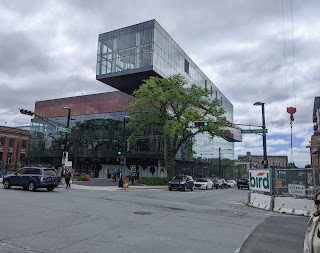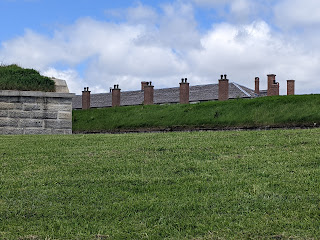
Steven and I were so lucky to have spent a couple of blissful days with my dear friend, Lezlie, and her partner, David, in the stunning home she designed in the bayside town of Chester on Nova Scotia's South Shore. The town was first settled by New Englanders in 1759 at the northern end of Mahone Bay. Since the town's first hotel was built in 1827, the community has been a popular summer retreat due to its perfect sailing conditions and many vacation properties.
Their and our Lunenburg-based friends, Ellen and Peter, picked us up in Chester and we followed them into Halifax so they could show us around the city Steven and I hadn't visited for a good twenty-five years or so. Halifax was founded in Canada in 1749 when Colonel Edward Cornwallis led a group of British settlers who built houses and a stockade with St Paul’s Church built the next year. Halifax was founded as a fortified town as a counterbalance to Louisbourg, the French stronghold in Cape Breton.
The native people of the area, the Mi’kmaq, objected and they made several raids until a peace treaty was made in 1761. Then during the Seven Years War (1756-1763), Halifax proved its worth as a naval base. Halifax Naval Yard was built in 1759 and the city continued to be an important naval base during the late 18th century and the 19th century.
After the Seven Years' War, Protestants from Germany and the Netherlands settled in Nova Scotia. Then, during the American War of Independence (1776-1783), many refugees, known as Loyalists to Canadians but as "traitors" to Americans, arrived in Halifax. During the 19th century, Halifax prospered and it was incorporated as a city in 1842. In the late 19th century industries like cotton and sugar refining thrived in Halifax.
The Halifax Central Library was certainly far different than any library I was used to growing up in Ottawa way back when! Its inventive and welcoming architecture was a far cry from the 'shh' staid libraries of yore.
I give Lezlie credit for her description of us in this photo in the library lobby: "Love among the miniatures."
From the cafe on the library's top floor, we had a lovely panoramic view of the city's skyline.
Photos from Lezlie and David's Halifax highrise show the city is not just the capital of Nova Scotia, it is also the commercial hub of Canada's Maritime provinces. As well as being an important harbor, the Halifax region is an important center for research with six institutions of higher learning.
A few blocks away in the city's heart were the Halifax Public Gardens, one of the finest surviving examples of a Victorian garden in North America. First established in 1836 as the original garden space for the Nova Scotia Horticultural Society, the Gardens were transformed into an urban oasis by the amalgamation of two adjoining gardens, a swampy piece of wasteland, and an estate bequest.
Diana: These Japanese red maples reminded me of your love for these trees.
Camera-shy Ellen finally allowed me to take a photo of her in front of the oak tree planted in 1939 by His Majesty King George VI in the presence of the future Queen Elizabeth II.
When Ellen nicknamed Peter and Steven as "The Two Old Guys," I couldn't help but smile, too!
The Bandstand was added in 1887 and restored to its original detail in 2011. Haligonians - Halifax residents - are fortunate to enjoy twice-weekly afternoon concerts at the bandstand during the summer.
Horticultural Hall:
Above the city's downtown, Halifax was still dominated by a star-shaped, hilltop Citadel which was built in 1856 and originally commissioned by Prince Edward in 1803. It was an excellent example of a 19th-century British fort that never actually saw battle. I read that the Citadel park interpreters wear British uniforms and interact with visitors to show what life was like here for the 78th Highlanders and the 3rd Brigade Royal Artillery and their families.
The moving Explosion Monument in the shape of a bombed home ripped apart, stood on a hill overlooking the harbor at Fort Needham Park. In December of 1917, the Mont-Blanc, a French munitions ship, bound for the Western Front, collided in Halifax's busy harbor with the Imo, a Belgian relief ship. The Mont-Blanc was fully loaded with high explosives, picric acid, and the high-octane fuel, benzole. The resultant cataclysmic explosion was the largest manmade detonation until the nuclear bomb!
The numbers were almost incomprehensible: 1 of every 5 was injured; 1 of every 10 was left homeless, and 1 of every 25 was killed.
Thank God the number of terrible injuries led to advances in medical treatment, particularly in pediatric surgery.
Nearly 2,000 people lost their lives instantly, and another 9,000 were horrifically injured. Halifax's north end simply disappeared. The force of the explosion was so violent that a three-ton anchor was found two miles away.
The Memorial Bell Tower overlooked the harbor and the location of Pier 6 where the Mont-Blanc exploded that fateful December morning. It was moving to hear that the carillon bell rings daily in memory of those who suffered from the blast.
The block was an image of how Halifax appeared in 1918 and again in 1921.
When destroyed neighborhoods were rebuilt to safer standards following the Explosion, they incorporated innovative urban design. One was the use of Hydrostone, a term unique to Halifax, Peter explained to us. It was a building material that looked like concrete and was used to construct homes 'down and dirty' in an affordable fashion. Peter pointed out these homes that had been made with hydrostone.
We stopped at a fun place to munch on pizza as we watched the world go by.
Our excellent tour guides, Ellen and Peter, then took us to Fairview Lawn Cemetery perhaps best known as the final resting place for over one hundred victims of the sinking of the Titanic. The ship left on her maiden voyage on April 10, 1912, with over 2,200 passengers and crew onboard. Just four days later, after striking an iceberg south of Newfoundland, it sank in just two hours and 40 minutes.
Just over 700 survivors on lifeboats were rescued and taken to New York. The White Star Line, the company that owned the Titanic and which had offices in Halifax, commissioned four Canadian vessels to search for bodies. Of the 328 victims that were recovered, many were buried at sea but over 200 were brought to Halifax, the nearest major port to where the ship had sunk. All those thought to be Protestant were buried here at Fairview Lane when the White Star Line commissioned a well-known surveyor to design the Titanic plot into the shape of the hill at the cemetery.
Some of the graves had no name because there was no distinguishing mark or personal effects that could be used to identify a body. However, some of the victims have subsequently been ID'ed thanks to careful research based on details in the coroner's files. Research has also shown that some of the names on the gravestones are or were misspelled. As recently as 1991, five more people have been identified thanks to DNA testing and initials sewn on undergarments that were then matched with the manifest.
Some of the gravestones were of different sizes because some families, friends, or other groups paid for more elaborate stones than the small 'black granite' headstones that were paid for by the White Star Line who purchased a section of land in the cemetery.
I hadn't realized that there were three times as many men as women on board the Titanic. However, the percentage of women who survived was far greater because the crew gave preference to women and children as the ship was sinking.
One of the most heartbreaking sights in the Titanic section was this gravestone to "the memory of the unknown child" whose body was recovered at the site of the disaster. Ellen mentioned that local schoolchildren often leave small gifts at the gravesite that had been paid for by the crew who found the body. Thanks to the latest in DNA technology, the 13-month-old was identified 90 years later as one of five Finnish sons who perished with their mother.
The cemetery was also the final resting place for many victims of the Halifax Explosion.
Though we'd thoroughly enjoyed our whistle-stop tour of Halifax's most celebrated sights, Steven and I were even happier to move on to Ellen and Peter's adopted hometown of Lunenburg, located about an hour west of the capital.
Yeah, we reached Lunenburg, our home for the next three nights courtesy of Ellen and Peter! I could almost literally feel Ellen let out a big sigh of relief the further we got from the Big City even though Halifax is a vibrant city with beautiful shops and sights.
Next post: Discovering Nova Scotia's Lighthouse Route thanks to our guides and friends Ellen and Peter - lucky us!
Posted very late on August 7th, 2022, on our last night here in Gulf Shores, Alabama, as we very slowly make our way home to Denver detouring first to northwest Arkansas for three days to see a famous museum and then northeast to Chicago to visit our second daughter and her family for a few precious days.























































What a wonderful day you enjoyed with fabulous old friends/tour guides, sun in the sky, history on the ground and Maritime love in the sea air. Thanks for the ride through Halifax, a favourite city of mine and my gals. xo
ReplyDeleteThanks, Lina, for reading and kindly commenting about our great day touring Halifax with Ellen and Peter. It was such a treat being driven around and guided to do many charming places in Halifax.
ReplyDelete